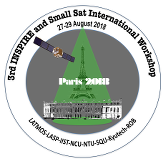Speaker
Dr
Eric Chassefière
(GEOPS, Univ. Paris-Sud, CNRS, Université Paris-Saclay)
Description
MPVIEW (Multi Platform Venus Imager to Elucidate Waves) is a small multi-satellite mapping system to fully monitor and characterize waves in Venus’ atmosphere. It is deployed sequentially by a mother spacecraft initially inserted in a high apoapsis equatorial orbit during the downsizing of the initial orbit to the final orbit of observation.
To understand the angular momentum budget that maintain superrotation, general circulation models are valuable tools. They show that mean meridional circulation, thermal tides (diurnal and semi-diurnal components) and planetary-scale waves (periods around 4-6 Earth days, wavenumbers 1 or 2) play a role in this subtle balance. To validate the simulations, it is crucial to characterize these three components through observations. However, these observations and characterizations are difficult. One way would be to monitor the full range of longitudes during a significant time period. Thermal infrared is the only wavelength range where day and night sides can be observed at the same time.
Such a coverage would give the temperature, zonal and meridional wind fields at the cloud-top, and could help characterize the major players in the angular momentum transport, at least near the cloud-top. While it is not enough to fully characterize the circulation through observations only, it would be a crucial constraint to validate circulation models.
This coverage would also give access to a full monitoring of the stationary waves that have been observed by Akatsuki and that are related to interaction of mountains with the near-surface flow. This monitoring (timing, frequency, position, variability of the bow-shaped waves) would give constraints on the modeling of the near-surface circulation, which is an additional and very valuable constraint on the GCM simulations and on the atmosphere-surface interaction.
The ideal configuration to monitor waves would be a constellation of 3 small satellites all orbiting Venus on the same equatorial circular orbit and located at 120° from each other, that is forming an equilateral triangle. These satellites have to be equipped with a long wave infrared camera similar to the LIR instrument onboard Akatsuki providing a full thermal infrared image of a wide equator-centered latitudinal band. Assuming a typical field of view of 0.3 rad and a scale of 1 mrad/px, and a typical orbit radius of 40 000 km, each imager would cover the whole Venus disk with a nadir spatial resolution of ≈40 km.
The most natural way to proceed is to release 2 small nadir-pointing satellites from 1 mother spacecraft after Venus equatorial orbit insertion and to use the mother spacecraft as a third observation platform. It is not possible to achieve the ideal configuration described above, which would require unrealistically large propulsion resources. Assuming that the main spacecraft in inserted in a large apoapsis elliptical orbit with a further progressive reduction of the apoapsis altitude, it is relatively easy and only little energy-consuming to release the small satellites from predefined intermediate orbits. In this way, the 3 observation platforms may be placed on coplanar elliptical orbits of different apoapsis (and to some extent periapsis) altitudes, with different orbital periods, allowing to observe simultaneously several longitude ranges.
We will present the results of a preliminary study aiming at characterizing the best solutions in terms of orbit parameters and periods to maximize the longitudinal coverage of MPVIEW in order to monitor and fully characterize the complex wave system in Venus’ atmosphere.
Primary author
Dr
Eric Chassefière
(GEOPS, Univ. Paris-Sud, CNRS, Université Paris-Saclay)
Co-authors
Dr
Michel Capderou
(LMD/IPSL, Ecole Polytechnique, CNRS)
Dr
Sébastien Lebonnois
(LMD/IPSL, Sorbonne Université, Campus P&M Curie, CNRS)

